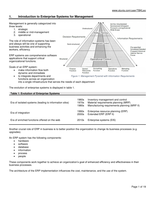Samenvatting
Summary L. Motiwalla, J. Thompson - Enterprise Systems for Management, 2nd edition 2014
- Vak
- 1BV20
- Instelling
- Technische Universiteit Eindhoven (TUE)
A useful and clear summary of 19 pages. Summarizes chapters: 1,2,3,4,8,10,11.
[Meer zien]





